NEET Alternating Current MCQs
NEET Physics For Alternating Current Multiple Choice Questions
Question 1. The peak voltage of the AC source is equal to:
- The value of the voltage supplied to the circuit
- The RMS value of the source
- \(\sqrt{2}\) times theRMS value of the ac source
- \(\frac{1}{\sqrt{2}}\)times the RMS value of the ac source
Answer: 3. \(\sqrt{2}\) times the RMS value of the ac source
We know that, \(v_{r m s}=\frac{v_o}{\sqrt{2}}\)
∴ \(v_0=\sqrt{2} v_{r m s}\)
Question 2. The variation of EMF with time for four types of generators is shown in the figures. Which amongst them can be called AC?
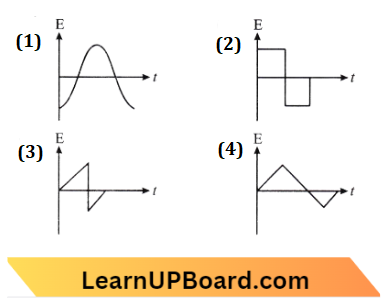
- 1 and 4
- 1 and 2
- 1, 2 and 4
- only 1
Answer:2. 1 and 2
Ac waves are generally of a sinusoidal nature or which is positive for half cycle and negative for the other half cycle which is satisfied by all 4 options.
Alternating Current MCQs For NEET
Question 3. A light bulb and an inductor coil are connected to an AC source through a key as shown in the figure below. The key is closed and after some time an iron rod is inserted into the interior of the inductor. The glow of a light bulb:

- decreases
- remains unchanged
- will fluctuate
- increases
Answer: 1. decreases
The diagram is shown in the figure.
Given
A light bulb and an inductor coil are connected to an AC source through a key as shown in the figure below. The key is closed and after some time an iron rod is inserted into the interior of the inductor.
According to the question the key is closed and when the iron rod is inserted inside the inductor the inductance (L) of the coil increases.

When L increases then inductive reactance \(X_L=\omega\) L also increases.
When \(X_L \)increases then current I decrease which is confirmed by the equation. I=\(\frac{e}{X_L}\)
Since \(X_L\) increases, hence I decrease and the glow of the bulb also decreases.
Read and Learn More NEET Physics MCQs
Alternating Current MCQs For NEET
Question 4. A coil of self-inductance L is connected in series with a bulb B and AC source. The brightness of the bulb decreases when:
- frequency of the AC source is decreased
- number of turns in the coil is reduced
- a capacitance of reactance XQ= XL is included in the same circuit
- an iron rod is inserted into the coil
Answer: 4. an iron rod is inserted into the coil
Given
A coil of self-inductance L is connected in series with a bulb B and AC source.
We know that and Z=\(\sqrt{R^2+X_L^2}=\sqrt{R^2+(2 \pi f L)^2} \)
I=\(\frac{V}{Z}, P=I^2 R\)
i.e. V \(\uparrow L \uparrow=Z \uparrow\)
Question 5. In The circuit of the figure, the bulb will become suddenly bright, if:
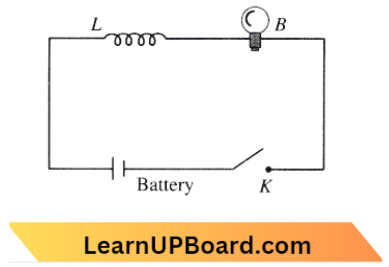
- contact’s is made or broken
- contact is made
- contact is broken
- None of the above
Answer: 3. contact is broken
Self-induced current flows in the direction of the main current when the contact is suddenly broken. As a result, the bulb B will instantaneously become bright.
Alternating Current Questions NEET
Question 6. A 40 μF capacitor is connected to a 200 V, 50 Hz AC supply. The RMS value of the current in the circuit is, nearly:
- 2.05 A
- 2.5 A
- 25.1 A
- 1.7 A
Answer: 2. 2.5 A
Given
A 40 μF capacitor is connected to a 200 V, 50 Hz AC supply.
From the question,
C=40 \(\mu \mathrm{F}=40 \times 10^{-6} \mathrm{~F}, V_{r m s}=200 \mathrm{~V}, v=50 \mathrm{~Hz}\)
⇒ \(\mathrm{X}_{\mathrm{C}} =\frac{1}{2 \pi \nu \mathrm{C}}=\frac{1}{2 \pi \times 50 \times 40 \times 10^{-6}} \)
= \(\frac{10^6}{100 \pi \times 40}=\frac{250}{\pi} \Omega \)
∴ \(\mathrm{I}_{r m s} =\frac{\mathrm{V}_{r m s}}{X_C}=\frac{\frac{200}{250}}{\pi}=2.5 \mathrm{~A}\).
Question 7. A 100 Ω resistance and capacitor of 100 Q reactance are connected in series across a 220 V source. When the capacitor is 50% charged, the peak value of the displacement current is:
- 2.2 A
- 11 A
- 4.4 A
- 1 √2 A
Answer: 1. 2.2 A
Given
A 100 Ω resistance and capacitor of 100 Q reactance are connected in series across a 220 V source.
We know that the impedance of the R-C circuit,
Z= \(\sqrt{R^2+X_C^2}\)
Here R=100 \(\Omega, X_C=100 \Omega \)
Z= \(\sqrt{(100)^2+(100)^2}=100 \sqrt{2} \Omega \)
Peak value of current,
∴ –\(\mathrm{I}_{\max }=\frac{V_{\max }}{2}=\frac{220 \sqrt{2}}{100 \sqrt{2}}=2.2 \mathrm{~A}\)
Alternating Current Questions NEET
Question 8. The reactance of a capacitor of capacitance C is X. If both the frequency and capacitance are doubled, then the new reactance will be:
- X
- 2 x
- 4 x
- \(\frac{X}{4}\)
Answer: 4. \(\frac{X}{4}\)
When an AC signal is coupled to a capacitor with capacitance C, the circuit’s reactance is simply capacitive.
We have, the capacitive reactance,
⇒ \(X_C =\frac{1}{\omega C}=\frac{1}{2 \pi f C} \quad(\omega=2 \pi f) \)
⇒ \(\mathrm{X}_C \propto \frac{1}{f C}\)=0
Considering two different cases of frequency and capacitance, we have
⇒ \(\frac{X}{X}=\frac{f C}{f^{\prime} C}=\frac{f \times C}{2 f \times 2 C}\)
f=2 f and \(C^{\prime}\)=2 C
⇒ \(\frac{X}{X}=\frac{1}{4} \)
∴ \(X^{\prime}=\frac{X}{4}\)
Question 9. A series LCR circuit with inductance 10H capacitance I OpF, resistance 50\(\Omega\) is connected to the AC source of voltage, V = 200 sin (100 t) volt. If the resonant frequency of the LCR circuit is vQ and the frequency of the a.c. the source is v, then :
- \(v_0=v=50 \mathrm{~Hz}\)
- \(v_0=v=\frac{50}{\pi} \mathrm{Hz}\)
- \(v_0=\frac{50}{\pi} \mathrm{Hz}, v=50 \mathrm{~Hz}\)
- \(v_0=100 \mathrm{~Hz}, v_0=\frac{100}{\pi} \mathrm{Hz}\)
Answer: 2. \(v_0=v=\frac{50}{\pi} \mathrm{Hz}\)
Given, C=10 \(\mu F, R=50 \Omega, L=10 \mathrm{H} \)
⇒ \(\omega=2 \pi \nu\)
v=\(\frac{\omega}{2 \pi}=\frac{100}{2 \pi}=\frac{50}{\pi} \mathrm{Hz} \)
Resonance, \(v_{\mathrm{r}}=v_{\mathrm{o}} \)
= \(\frac{1}{2 \pi \sqrt{L C}}\)
= \(\frac{1}{2 \pi \sqrt{10 \times 10 \times 10^{-6}}} \)
= \(\frac{100}{2 \pi} \)
= \(\frac{50}{\pi} \mathrm{Hz} \)
Alternating Current Mcqs With Answers
Question 10. An inductor of inductance L, a capacitor of capacitance C, and a resistor of resistance ‘R’ are connected in series to an AC source of potential difference ‘ V volts as shown in the figure.
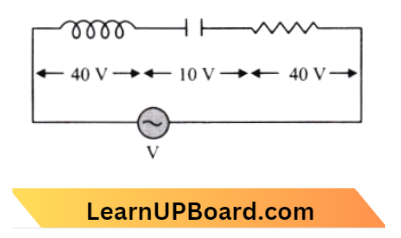
The potential difference across L, C, and R is 40 V, 10 V, and 40 V, respectively. The amplitude of the current flowing through the LCR series circuit is 10\(\sqrt{2}\) A. The impedance of the circuits is:
- 4 \(\sqrt{2} \Omega\)
- 5 \(\sqrt{2} \Omega\)
- 4 \(\Omega\)
- 5 \(\Omega\)
Answer: 4. 5 \(\Omega\)
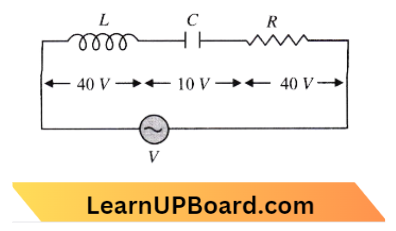
Given, \(V_L =40 \mathrm{~V} \)
⇒ \(V_C =10 \mathrm{~V} \)
⇒ \(V_R =40 \mathrm{~V} \)
⇒ \(I_0 =10 \sqrt{2}\)
⇒ \(\mathrm{Z}\) =?
We know, \(\mathrm{Z} =\sqrt{\mathrm{R}^2+\left(\mathrm{X}_{\mathrm{L}}-\mathrm{X}_{\mathrm{C}}\right)^2} \)
V=I Z =\(\sqrt{\mathrm{I}^2 \mathrm{R}^2+\left(\mathrm{IX}_{\mathrm{L}}-\mathrm{IX}_{\mathrm{C}}\right)}\)
V =\(\sqrt{1600+900}=50 \mathrm{~V} \)
⇒ \(I_{R M S} =\frac{I_0}{\sqrt{2}}=\frac{10 \sqrt{2}}{\sqrt{2}}=10 \mathrm{~A}\)
Z = \(\frac{V_{R M S}}{I_{R M S}}=\frac{50}{10}=5 \Omega\)
Question 11. A circuit when connected to an AC source of 12 V gives a current of 0.2 A. The same circuit when connected to a DC source of 12 V, gives a current of 0.4 A. The circuit is:
- series LR
- series RC
- series LC
- series LCR
Answer: 4. series LCR
Given
A circuit when connected to an AC source of 12 V gives a current of 0.2 A. The same circuit when connected to a DC source of 12 V, gives a current of 0.4 A.
⇒ \(I_1=\frac{V}{Z}\)
⇒ \(I_1=\frac{12}{\sqrt{R^2+\left(X_L-X_C\right)^2}}=0.2 \mathrm{~A}\)
In the second case for the DC source, the capacitor would provide infinite resistance but current is present in the circuit, which means the resistor and inductor can be present in the circuit.
As the current with the AC source and DC source are different, the inductor must be present with resistance.
Alternating Current Mcqs With Answers
Question 12. The figure shows a circuit that contains three identical resistors with resistance R = 9.0 fi each, two identical inductors with inductance L = 2.0 mH each and an ideal battery with emf E = 18 V. The current I through the battery just after the switch closed is:
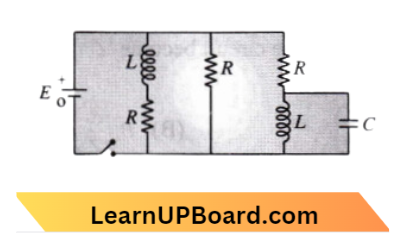
- 2 mA
- 0.2 A
- 2 A
- 0 A
Answer: 3. 2 A
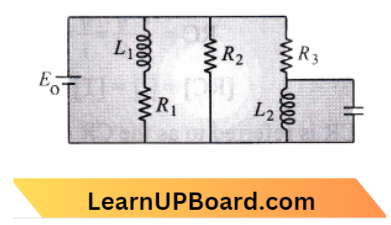
At, t = 0 no current flows through \(R_1\) and \(R_3.\)
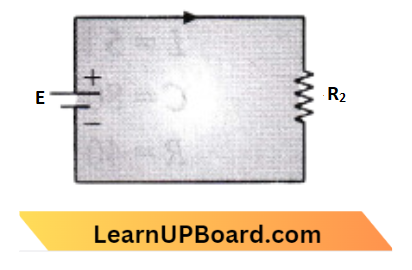
i=\(\frac{E}{R_2} =\frac{18}{9}=2 \mathrm{~A}\) [since E=18 \(\mathrm{~V}, R_2=9 \Omega]\)
Question 13. Which of the following combinations should be selected for better tuning of an L-C-R circuit used for communication?
- R=200 \(\Omega, L=1.5 H, \mathrm{C}=35 \mu \mathrm{F} \)
- R=25 \(\Omega, L=2.5 H, \mathrm{C}=45 \mu \mathrm{F} \)
- R=15 \(\Omega, L=3.5 H, \mathrm{C}=30 \mu \mathrm{F} \)
- R=25 \(\Omega, L=1.5 \mathrm{H}, \mathrm{C}=45 \mu \mathrm{F}\)
Answer: 3. R=15 \(\Omega, L=3.5 H, \mathrm{C}=30 \mu \mathrm{F} \)
Q=\(\frac{\omega_0 L}{R}\)
Q=\(\frac{1}{\sqrt{L C}}\left(\frac{L}{R}\right)=\frac{1}{R} \sqrt{\frac{L}{C}}\)
R and C should be small and L should be high. So, option (3) is correct.
Question 14. A series R-C circuit is connected to an alternating voltage source. Consider two situations:
1. When the capacitor is air-filled.
2. When the capacitor is mica filled.
Current through the resistor is i and voltage across the capacitor is V then:
- \(V_a<V_b\)
- \(V_a>V_b\)
- \(i_a>i_b\)
- \(V_a=V_b\)
Answer: 2. \(V_a>V_b\)
When the capacitor is filled with mica then capacitance C increases so \(X_c\) decreases. In case (2) \(X_c\) decreases so the voltage across the capacitor decreases.
∴ \(V_a>V_b\)
Alternating Current Mcqs With Answers
Question 15. In an electrical “circuit R, L, C, and an AC voltage source are all connected in series. When L is removed from the circuit, the phase difference between the voltage and the current in the circuit is \(\frac{\pi}{3}\). If instead, C is removed from the circuit, the phase difference is again \(\pi / 3\). The power factor of the circuit is:
- \(\frac{1}{2}\)
- 1 \(\sqrt{2}\)
- 1
- \(\frac{\sqrt{3}}{2}$\)
Answer: 3. 1
Given
In an electrical “circuit R, L, C, and an AC voltage source are all connected in series. When L is removed from the circuit, the phase difference between the voltage and the current in the circuit is \(\frac{\pi}{3}\). If instead, C is removed from the circuit, the phase difference is again \(\pi / 3\).
According to the question
Phase difference, \(\tan \phi =\frac{X_L-X_C}{R}\)
⇒ \(\tan \frac{\pi}{3} =\frac{X_L-X_C}{R}\) → Equation 1
When \mathrm{L} is removed then,
⇒ \(\sqrt{3}=\frac{X_C}{R} X_C=\sqrt{3} R\)
When C is removed then
⇒ \(\tan \frac{\mathrm{p}}{3} =\sqrt{3}=\frac{\mathrm{X}_{\mathrm{L}}}{R} \)
⇒ \(X_{\mathrm{L}} =\sqrt{3} \cdot R\)
From eq. (1),
⇒ \(\tan \phi =\frac{\sqrt{3} R-\sqrt{3} R}{R}\)=0
⇒ \(\phi\) =0
Power factor, \(\cos \phi\) =1
Question 16. An AC voltage is applied to a resistance R and an inductor L in series. If R and the inductive reactance are both equal to 3 Ω the phase difference between the applied voltage and the current in the circuit is:
- \(\frac{\pi}{4}\)
- \(\frac{\pi}{2}\)
- zero
- \(\frac{\pi}{6}\)
Answer: 1. \(\frac{\pi}{4}\)
Given
An AC voltage is applied to a resistance R and an inductor L in series. If R and the inductive reactance are both equal to 3 Ω
We know that, \(\tan \phi=\frac{X_L}{R}=\frac{L \omega}{R}\)
and \(\tan \phi =\frac{3 \Omega}{3 \Omega}\)
⇒ \(\tan \phi\) =1
⇒ \(\phi =45^{\circ} \)
∴ \(\phi =\frac{\pi}{4} \mathrm{rad}\)
NEET Physics Important Questions
Question 17. A coil has a resistance of 30 Ω and an inductive resistance of 20 Ω at 50 Hz frequency. If an AC source of 200 V. 100 Hz. is connected across the coil, the current in the coil will be :
- 4.0 A
- 8.0 A
- \(\frac{20}{\sqrt{13}} \mathrm{~A}\)
- 2.0A
Answer: 1. 4.0 A
Given
A coil has a resistance of 30 Ω and an inductive resistance of 20 Ω at 50 Hz frequency. If an AC source of 200 V. 100 Hz. is connected across the coil
According to the question
and \(\omega =50 \times 2 \pi, \omega L=20 \Omega\)
⇒ \(\omega^{\prime} =100 \times 2 \pi\), then \(\omega^{\prime} L=40 \Omega\)
Then, I =\(\frac{200}{Z}=\frac{200}{\sqrt{\mathrm{R}^2+\left(\omega^{\prime} \mathrm{L}\right)^2}}\)
= \(\frac{200}{\sqrt{(30)^2+(40)^2}}=4 \mathrm{~A}\)
Question 18. In the given circuit the reading of voltmeter Vl and V2 are 300 V each. The reading to the voltmeter V3 and ammeter A are respectively:
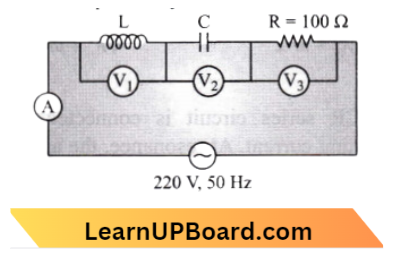
- 150 V, 2.2 A
- 220 V, 2.2 A
- 220 V, 2.0 A
- 100 V, 2.0 A
Answer: 2. 220 V, 2.2 A
For series LCR circuit Voltage,
V=\(\sqrt{V_R^2+\left(V_L-V_C\right)^2}\)
since, \(V_L=V_C\)
Hence,V=\(V_R=220 \mathrm{~V}\)
I=\(\frac{V}{R}=\frac{220}{100}=2.2 \mathrm{~A}\)
NEET Physics Important Questions
Question 19. What is the value of inductance L for which the current is maximum in a series LCR circuit with C = 10 pF and co = 1000 s-1?
- 1 mH
- cannot be calculated unless R is known
- 10 mH
- 100 mH.
Answer: 4. 100 mH.
According to the question current is maximum at resonance
⇒ \(\omega^2 =\frac{1}{L C}\)
L =\(\frac{1}{\omega^2 C} \)
= \(\frac{1}{(1000)^2\left(10 \times 10^{-6}\right)}\)
= 0.1 \(\dot{\mathrm{H}}=100 \mathrm{mH}\)
Question 20. A coil of inductive reactance 31 Ω. has a resistance of 8 Ω. It is placed in series with a condenser of capacitative reactance 25 Ω. The combination is connected to an a.c. source of 110 V. The power factor of the circuit is:
- 0.33
- 0.56
- 0.64
- 0.80
Answer: 4. 0.80
Given
A coil of inductive reactance 31 Ω. has a resistance of 8 Ω. It is placed in series with a condenser of capacitative reactance 25 Ω. The combination is connected to an a.c. source of 110 V.
⇒ \(X_L=31 \Omega, X_C=25 \Omega, R=8 \Omega\)
The impedance of series LCR is
Z= \(\sqrt{R^2+\left(X_L-X_C\right)^2}\)
Z= \(\sqrt{8^2+(31-25)^2} \)
Z= \(\sqrt{64+36}\)
Z= \(\sqrt{100}=10 \Omega\)
Power factor, \(\cos \phi=\frac{R}{Z}=\frac{8}{10}=0.8\)
Alternating Current Practice NEET
Question 21. In a circuit l, c, and r are connected in series with an alternating voltage source of frequency f. The current leads the voltage by 45°. The value of c is:
- \(\frac{1}{\pi f(2 \pi f(L-R)}\)
- \(\frac{1}{2 \pi f(2 \pi f L-R)}\)
- \(\frac{1}{\pi f(2 \pi f L+R)}\)
- \(\frac{1}{2 \pi f(2 \pi f L+R)}\)
Answer: 4. \(\frac{1}{2 \pi f(2 \pi f L+R)}\)
⇒ \(\tan \phi =\frac{X_C-X_L}{R}\)
⇒ \(\tan \left(\frac{\pi}{4}\right) =\frac{\frac{1}{\omega C}-\omega L}{R} \)
R =\(\frac{1}{\omega C}-\omega L \)
⇒ \((R+2 \pi f L) =\frac{2}{2 \pi f C} \)
Or C =\(\frac{1}{2 \pi f(R+2 \pi f L)}\)
Question 22. A coil of 40 Henry inductance is connected in series with a resistance of 8 ohm and the combination is joined to the terminals of a 2-volt battery. The time constant of the circuit is:
- 5 seconds
- 1/5 seconds
- 40 seconds
- 20 seconds
Answer: 1. 5 seconds
Given
A coil of 40 Henry inductance is connected in series with a resistance of 8 ohm and the combination is joined to the terminals of a 2-volt battery.
According to the question
Time constant LR circuit is \(\tau=\frac{L}{R}\)
∴ \(\tau=40 / 8=5 \mathrm{sec}\)
Question 23. For a series LCR circuit, the power loss at resonance is:
- \(\frac{V^2}{\left(\omega L-\frac{1}{\omega C}\right)}\)
- \(I^2 L \omega\)
- \(I^2 R\)
- \(\frac{V^2}{C \omega}\)
Answer: 3. \(I^2 R\)
Power loss is given by,
P=V I \(\cos \phi\)
At resonance current and voltage are in the same phase, that is \(\phi\)=0.
P=V I\( \cos 0=V I=I^2 R\)
NEET Physics Mcqs Alternating Current
Question 24. A wire of resistance R is connected in series with an inductor of reactance oiL. The quality factor of the RL circuit is:
- \(\frac{R}{\omega L}\)
- \(\frac{\omega L}{R}\)
- \(\frac{R}{\sqrt{R^2+\omega^2 L^2}}\)
- \(\frac{\omega L}{\sqrt{R^2+\omega^2 L^2}}\)
Answer: 2. \(\frac{\omega L}{R}\)
Given
We have,
A wire of resistance R is connected in series with an inductor of reactance oiL.
Quality factor,Q=2 \(\pi \times \frac{\text { total energy stored in the circuit }}{\text { loss in energy in each cycle }}\)
But the total energy stored in circuit =\(\mathrm{Li}^2{ }_{\mathrm{ms}}\) and the energy loss per second =\(i^2{ }_{\mathrm{ms}}\)
So, energy lose per cycle =\(\frac{i_{m s}^2 R}{f}\)
⇒ \(\mathrm{Q}=2 \pi \times \frac{L i_{m s}^2}{i_{m s}^2 R / f} \)
∴ \(\mathrm{Q}=\frac{2 \pi f L}{R}=\frac{\omega L}{R}\)
Question 25. An LCR series circuit is connected to a source of alternating current. At resonance, the applied voltage and the current flowing through the circuit will have a phase difference of:
- \(\pi\)
- 0
- \(\frac{\pi}{4}\)
- \(\frac{R}{C}\)
Answer: 2. 0
A circuit that allows maximum current by connecting inductance L, capacitance C, and resistance R in series. It is the series resonance circuit that corresponds to a specific AC frequency. An RLC circuit’s impedance (Z) is given by
⇒ \(\mathrm{Z}={\sqrt{R^2+\left(\omega L-\frac{1}{\omega C}\right)}}^2\)
At resonance,\( X_L=X_C\)
i.e. \(\omega L=\frac{1}{\omega C}\) or Z=R
As a result, the circuit behaves as if it just has R. So, phase difference =0.
NEET Physics Mcqs Alternating Current
Question 26. The time constant of the C-R circuit is:
- \(\frac{1}{C R}\)
- \(\frac{C}{R}\)
- \(\mathrm{CR}\)
- \(\frac{R}{C}\)
Answer: 3. \(\mathrm{CR}\)
We have, R =\(\frac{V}{i} \text { and } C=\frac{q}{V} \)
⇒ \(\mathrm{RC} =\frac{V}{i} \frac{q}{V}=\frac{q}{i}=\frac{i \times t}{i}\)=t
⇒ \({[\mathrm{RC}] } =[t]=[\mathrm{T}]\)
CR is referred to as the CR circuit’s time constant.
Question 27. A series LCR circuit containing a 5.0 H inductor, 80 μF capacitor, and 40 Ω resistor is connected to a 230 V variable frequency AC source. The angular frequencies of the source at which power transferred to the circuit are half the power at the resonant angular frequency are likely to be:
- 25 rad/s and 75 rad/s
- 50 rad/s and 25 rad/s
- 46 rad/s and 54 rad/s
- 42 rad/s and 58 rad/s
Answer: 3. 46 rad/s and 54 rad/s
Given, L =5 \(\mathrm{H} \)
C =80 \(\mu \mathrm{F} \)
R =40 \(\Omega\)
r =230 \(\mathrm{~V}\)
Let the frequencies be
⇒ \(\omega^{\prime}=\omega_R \pm \Delta \omega\)
where, \(\Delta \omega=\frac{R}{2 L}\)
⇒ \(\Delta \omega=\frac{40}{2 \times 5}=4 \mathrm{rad} / \mathrm{s}\)
And \(\omega_{\mathrm{R}}=\frac{1}{\sqrt{L C}}=50 \mathrm{rad} / \mathrm{s}\)
Frequencies are 50-4 and 50+4
= 46 \(\mathrm{rad} / \mathrm{s}\) and 54 \(\mathrm{rad} / \mathrm{s}\)
Question 28. A series L-C-R circuit is connected to an AC voltage source. When L is removed from the circuit, the phase difference between current and voltage is \(\frac{\pi}{3}\). If instead C is removed from the circuit, the phase difference is again \(\frac{\pi}{3}\) between current and voltage. The power factor of the circuit is:
- 0.5
- 1.0
- -10
- zero
Answer: 2. 1.0
For LCR circuit phase difference,
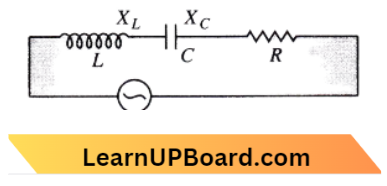
⇒ \(\phi=\tan ^{-1}\left[\frac{X_L-X_C}{R}\right]\)
When L is removed then \(X_L\)=0
⇒ \(\phi =\tan ^{-1}(\frac{-X_C}{R})\)
⇒ \(\tan \phi =|\frac{X_C}{R}|\) → Equation 1

When C is removed then \(X_C\)=0
⇒ \(\phi =\tan ^{-1}(\frac{X_L}{R})\)
⇒ \(\tan \phi =(\frac{X_L}{R})\) → Equation 2
From eq. (1) and eq. (2),
⇒ \(X_L =X_C \)
Impedance \(\mathrm{Z} =\sqrt{R^2+\left(X_L-X_C\right)^2}\)
Power Factor
⇒ \(\cos \phi=\frac{R^2}{Z}\)=1
Power factor \(\cos \phi\)=1.
Alternating Current NEET Questions
Question 29. An inductor of 20 mH, a capacitor of 100 μF, and a resistor of 50 Ω are connected in series across a source of emf, V= 10 sin 314 t. The power loss in the circuit is:
- 2.74 W
- 43 W
- 0.79 W
- 1.13 W
Answer: 3. 0.79 W
Given,Inductance, L=20 \(\mathrm{mH}=20 \times 10^{-3} \mathrm{H}\)
Capacitance, C=100 \(\mu \mathrm{F}=100 \times 10^{-6} \mathrm{~F}\)
Resistance,R=50 \(\Omega\)
V=10 \(\sin 314 t\) → Equation 1
and equation of emf is, V=\(V_0 \sin \omega t\) → Equation 2
Compare eq. (1) and (2),
⇒ \(V_0=10 \mathrm{~V}, and \omega=314 \mathrm{rad} \mathrm{s}^{-1}\)
Power of the AC circuit is, P =\(V_{r m s} I_{r m s} \cos \phi \)
= \(V_{r m s}\left(\frac{V_{r m s}}{Z}\right)\left(\frac{R}{Z}\right)=\left(\frac{V_{r m s}}{Z}\right)^2 R\)
P =\(\left(\frac{V_0}{\sqrt{2} \cdot Z}\right)^2 \cdot R\) → Equation 3
Impedance, Z=\(\sqrt{R^2+\left(X_L-X_C\right)^2}\)
= \(\sqrt{R^2+\left(\omega L-\frac{1}{\omega C}\right)^2} \)
= \(\sqrt{R^2+\left(\omega L-\frac{1}{\omega C}\right)^2} \)
= \(\sqrt{(50)^2+\left(\frac{1}{314 \times 100 \times 10^{-6}}-314 \times 20 \times 10^{-3}\right)^2} \)
= \(\sqrt{2500+(25.56)^2}=56 \Omega\)
Putting the value of Z=56 \(\Omega\) in eq. (2)
P =\(\left(\frac{10}{\sqrt{2} \times 56}\right)^2 \times 50\)
P =\(\frac{100}{2 \times 3136} \times 50 \)
P =0.79 \(\mathrm{~W}\)
Power loss =0.79 \(\mathrm{~W}\)
Question 30. An inductor 20 mH, a capacitor 50 μF, and a resistor 40Ω are connected in series across a source of emf, V = 10 sin 340t. The power loss in the AC circuit is:
- 0.67 W
- 0.76 W
- 0.89 W
- 0.51 W
Answer: 4. 0.51 W
According to the question
Induction L=20 \(\mathrm{mH}\)
Capacitance C=50 \(\mu \mathrm{F}\)
Resistance R=40 \(\mathrm{~W}\)
emf V=10 \(\sin 340 \mathrm{t}\)
Power loss in \(\mathrm{AC}\) is
P=\(I_v^2 R=\left[\frac{E_y}{2}\right]^2 \cdot R=\left(\frac{10}{\sqrt{2}}\right)^2\) .
= 40\(\left[\frac{1}{(40)^2+\left(340 \times 20 \times 10^3-\frac{1}{340 \times 50 \times 10^{-6}}\right)^2}\right]\)
= \(\frac{100}{2} \times 40 \times \frac{1}{1600+(6.8-58.8)^2} \)
= \(\frac{2000}{1600+2704}=0.51 \mathrm{~W}\)
Alternating Current NEET Questions
Question 31. The potential differences across the resistance capacitance and inductance are 80 V, 40 V, and 100 V respectively in an L-C-R circuit. The power factor of this circuit is:
- 0.4
- 0.5
- 0.8
- 1.0
Answer: 3. 0.8
For this, we know the formula,
⇒ \(\tan \phi =\frac{V_L-V_C}{V_R}=\frac{100-40}{80}=\frac{3}{4}\)
⇒ \(\phi =37^{\circ} \)
Power factor =\(\cos \phi=\cos 37^{\circ}\)
= \(\frac{4}{5}\) or 0.8
Question 32. A resistance ‘R’ draws power ‘F when connected to an AC source. If an inductance is introduced such that the impedance of the circuit becomes ‘Z the power drawn will be:
- P\(\left(\frac{R}{Z}\right)^2\)
- P \(\sqrt{\frac{R}{Z}}\)
- P\(\left(\frac{R}{Z}\right)\)
- P
Answer: 1. P\(\left(\frac{R}{Z}\right)^2\)
According to the question, the power drawn is
P =\(V_{\mathrm{rms}} \cdot I_{\mathrm{rms}}=V_{\mathrm{rms}} \cdot \frac{V_{\mathrm{rms}}}{R}\)
⇒ \(V_{\mathrm{ms}}^2\) =P R
When the inductor is connected in series with the resistor the power drawn is,
⇒ \(P^{\prime}=V_{\mathrm{rms}} \cdot I_{\mathrm{rms}} \cos \phi\)
Where, \(\phi\)= phase difference
⇒ \(^{\prime}=\frac{V_{\mathrm{ms}}^2}{R} \cdot \frac{R^2}{Z^2}=P \cdot R \cdot \frac{R}{Z^2}\)
∴ \(P^{\prime}=\frac{P \cdot R^2}{Z^2}=P\left(\frac{R}{Z}\right)^2\)
Question 33. The instantaneous value of alternating current and voltage in a circuit are given as:
i=\(\frac{1}{\sqrt{2}} \sin (100 \pi t)\) ampere
e=\(\frac{1}{\sqrt{2}} \sin \left(100 \pi t+\frac{\pi}{3}\right)\) volt
The average power in Watts consumed in the circuit is :
- \(\frac{1}{4}\)
- \(\frac{\sqrt{3}}{4}\)
- \(\frac{1}{2}\)
- \(\frac{1}{8}\)
Answer: 4. \(\frac{1}{8}\)
P =\(V_{\mathrm{rms}} I_{\mathrm{rms}} \cos \phi \)
= \(\frac{1}{2} \times \frac{1}{2} \times \cos \left(\frac{\pi}{3}\right)=\frac{1}{8} \mathrm{~W}\)
Question 34. The power dissipated in an L-C-R series circuit connected to an AC source of emf ε is:
- \(\frac{\varepsilon^2 R}{\left[R^2+\left(L \omega-\frac{1}{C \omega}\right)^2\right]}\)
- \(\frac{\varepsilon^2 \sqrt{R^2+\left(L \omega-\frac{1}{C \omega}\right)^2}}{R}\)
- \(\frac{\varepsilon^2\left[R^2+\left(L \omega-\frac{1}{C \omega}\right)^2\right]}{R}\)
- \(\frac{\varepsilon^2 R}{\sqrt{R^2+\left(L \omega-\frac{1}{C \omega}\right)^2}}\)
Answer: 1. \(\frac{\varepsilon^2 R}{\left[R^2+\left(L \omega-\frac{1}{C \omega}\right)^2\right]}\)
The power dissipated in series L-C-R
P=\(I_{\mathrm{rms}}{ }^2 R=\frac{E_{\mathrm{ms}}^2 R}{|Z|^2}\)
P=\(\frac{E^2 R}{\left[R^2+\left(\omega L-\frac{1}{\omega C}\right)^2\right]}\)
Question 35. In an AC circuit, the emf (e) and the current (i) at any instant are given respectively by:
e=\(E_0 \sin \omega t \)
i=\(I_0 \sin (\omega t-\phi T)\)
The average power in the circuit over one cycle of AC is:
- \(\frac{E_0 I_0}{2}\)
- \(\frac{E_0 I_0}{2} \sin \phi\)
- \(\frac{E_0 I_0}{2} \cos \phi\)
- \(E_0 I_0\)
Answer: 3. \(\frac{E_0 I_0}{2} \cos \phi\)
Power = rate of work done in one complete cycle
P \(\omega=\frac{W}{T}\)
P \(\omega=\frac{\left(\mathrm{E}_0 I_0 \cos \phi\right) T / 2}{T} \)
P \(\omega=\frac{\mathrm{E}_0 I_0 \cos \phi}{2}\)
Where \(\cos \phi\) is called the power factor of an AC circuit.
Question 36. An eclectic Kettle has two heating coils. When one of the coils is connected to a.c. source, the water in the kettle boils in 10 minutes. When the other coil is used the water boils in 40 minutes. If both the coils are connected in parallel the time taken by the same quantity of water to boil will be :
- 8 minute
- 4 minute
- 25 minute
- 15 minute
Answer: 1. 8 minute
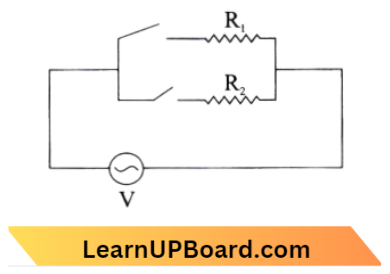
Here, Q =\(\frac{V^2}{R_1} \times t_1=\frac{V^2}{R_2} \times t_2 \)
=\(\frac{V^2}{R} \times t\)
⇒ \(\frac{1}{R} =\frac{1}{R_1}+\frac{1}{R_2}\)
⇒ \(\frac{Q}{V^2 t} =\frac{Q}{V^2 t_1}+\frac{Q}{V^2 t_2} \)
⇒ \(\frac{1}{t} =\frac{1}{t_1}+\frac{1}{t_4}\)
t =\(\frac{t_1 t_2}{t_1+t_2} \)
= \(\frac{10 \times 40}{10+40}=8 \mathrm{~min}\)
Question 37. A step-down transformer connected to an AC mains supply of 220 V is made to operate at 11 V, 44 W lamp. Ignoring power losses in the transformer, what is the current in the primary circuit?
- 0.2 A
- 0.4 A
- 2 A
- 4 A
Answer: 1. 0.2 A
Given, Step down transformer
⇒ \(V_P =220 \mathrm{~V}\)
⇒ \(V_S =11 \mathrm{~V} \)
⇒ \(P_S =44 \mathrm{~W}\)
⇒ \(I_P\) =?
⇒ \(P_P =P_S \)
⇒ \(V_P I_P =V_S I_S \)
⇒ \(I_S =\frac{P_s}{V_s}=4 \mathrm{~A}\)
∴ \(I_P =\frac{V_s I_s}{V_P} \)
= \(\frac{11 \times 4}{220}=\frac{4}{20} \)
= \(\frac{1}{5}=0.2 \mathrm{~A}\)
Question 38. A transformer having an efficiency of 90% is working on 200 V and 3 kW power supply. If the current in the secondary coil is 6 A, the voltage across the secondary coil and the current in the primary coil respectively are:
- 300 V, 15 A
- 450 V, 15 A
- 450 V, 13.5 A
- 600 V, 15 A
Answer: 2. 450 V, 15 A
According to the question,
Efficiency, 90 \%=0.9
Input voltage, \(V_P=200 \mathrm{~V}\)
Input power, \(P_P=300 \mathrm{~W}\)
Secondary coil current, \(I_S=6 \mathrm{~A}\)
⇒ \( V_P I_P \)=3000
⇒ \(I_P =\frac{3000}{V_P}=\frac{3000}{200}=15 \mathrm{~A}\)
Now efficiency =\(\frac{\text { Output }}{\text { input }}=\frac{V_S I_S}{V_P I_P}\)
0.9=\(\frac{V_S \times 6}{200 \times 15}\)
\(V_S=450 \mathrm{~V}\)Secondary coil current =450 \(\mathrm{~V}\).
Question 39. The primary winding of the transformer when connected to a DC battery of 10 Volt draws a current of 1 mA. The number of turns of the primary and secondary windings are 50 and 100 respectively. The voltage in the secondary and the current drawn by the circuit in the secondary are respectively:
- 20 V and 2.0 mA
- 10 V and 0.5 mA
- Zero volts and therefore no current
- 20 V and 0.5 mA
Answer: 3. Zero volt and therefore no current
The transformer can not work on DC.
Question 40. A 220 V input is supplied to a transformer. The output circuit draws a current of 2.0 A at 440 V. If the efficiency of the transformer is 80%, the current drawn by the primary windings of the transformer is:
- 3.6 A
- 2.8 A
- 2.5 A
- 5.0 A
Answer: 4. 5.0 A
Efficiency, n %=\(\frac{P_{\text {out }}}{P_{\text {in }}} \times 100 \)
= \(\frac{V_s i_s}{V_p i_p} \times 100\)
80=\(\frac{2 \times 440}{220 \times l_p} \times 100\)
∴ \(i_P=5 \mathrm{~A} \)
Question 41. The primary and secondary coils of a transformer have 50 and 1500 turns respectively. If the magnetic flux \(\phi\) linked with the primary coil is given by \(\phi=\phi_v+4\) t, where \(\phi\) is in webers, t is time in seconds and \(\phi_v\) is a constant, the output voltage across the output voltage across the secondary coil is:
- 120 volts
- 220 volts
- 30 volts
- 90 volts.
Answer: 1. 120 volts
According to the question,
⇒ \(N_p =50, N_s\)=1500
⇒ \(\phi =\phi_0+4 t\)
Voltage across primary coil,
⇒ \(V_p =\frac{d \phi}{d t}=\frac{d}{d t}\left(\phi_0+4 t\right)\)
= 4 volt
⇒ \(\frac{V_s}{V_p} =\frac{N_s}{N_p}\)
∴ \(V_s =\frac{1500}{50} \times 4=120 \mathrm{~V}\)
Question 42. A transformer is used to light a 100 W and 110 V lamp from a 220 V main. If the main current is 0.5 amp, the efficiency of the transformer is approximately:
- 50%
- 90%
- 10%
- 30%
Answer: 2. 90%
The efficiency of the transformer
⇒ \(\eta =\frac{V_s I_s}{V_p I_p} \times 100\)
=\(\frac{100}{220 \times 0.5} \times \)100=90 %
Question 43. The core of a transformer is laminated because:
- ratio of voltage in primary and secondary may be increased
- energy losses due to eddy currents may be minimized
- the weight of the transformer may be reduced
- rusting of the core may be prevented
Answer: 2. energy losses due to eddy currents may be minimized
The core of a transformer is laminated to minimize the energy losses due to eddy currents.
Question 44. A step-up transformer operates on a 230 V line and supplies a current of 2 A to a load. The ratio of the primary and secondary windings is 1:25. The current in the primary coil is
- 15 A
- 50 A
- 25 A
- 12.5 A
Answer: 2. 50 A
We have, the change in flux of the primary and secondary coils is proportional to the number of turns in the primary and secondary coils, respectively.
So, \(\frac{\phi_P}{N_P} =\frac{\phi_S}{N_S}\)
or \(\frac{1}{N_P} \times \frac{d \phi_P}{d t} =\frac{1}{N_S} \frac{d \phi_P}{d t}\)
∴ \(\frac{V_S}{V_P} =\frac{N_S}{N_P} \quad\left(\text { as } V \propto \frac{d \phi}{d t}\right)\)
Question 45. The primary winding of the transformer has 500 turns whereas its secondary has 5000 turns. The primary is connected to an AC supply of 20 V-50 Hz. The secondary will have an output of
- 2 V, 5 Hz
- 200 V, 500 Hz
- 2 V, 50 Hz
- 200 V, 50 Hz
Answer: 4. 200 V, 50 Hz
The transformer converts high-voltage AC into low-voltage AC without changing the frequency. The voltage across the input is divided by the voltage across the output.
We have, the voltage is given by,\(\frac{V_S}{V_P}=\frac{N_S}{N_P}\)
⇒ \(\mathrm{N}_{\mathrm{S}}\)= No. of turns in secondary coil \(\mathrm{N}_{\mathrm{P}}\)= No. of turns in the primary coil
⇒ \(\mathrm{V}_{\mathrm{S}}=\frac{N_S}{N_P} \mathrm{~V}_{\mathrm{P}}\)
Substitute the given values, we get
= \(\frac{5000}{500} \times 20\)=200 V
∴ Thus, the output has a voltage of 200 V and a frequency of 50 Hz.
